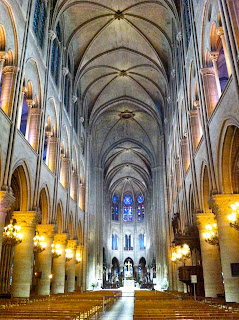Front row far left is Shuki Ronen next to Julien Meunier.
An action photo from the audience.
Feed back and Q thoughts
I am increasingly unhappy with one aspect of my DISC, namely the nature of my evidence that apparent and total attenuation are constant Q in nature. Of course, there is Attewell and Ramana (1966) who clearly indicate that in situ attenuation estimates across a broad frequency range is linear with frequency (implying constant Q). But my demonstration of constant Q from log data and broadband amplitude decay is weak. In searching for more direct and clear evidence, I have come up with a couple of ideas. First, if constant Q attenuation behavior is present in real data then we should be able to show it from the following simple argument. The constant Q amplitude model is
Ax = Ao exp[ - (pi f x) / (v Q) ]
where Ax is the peak amplitude of a wave with frequency f after traveling a distance x with velocity v through an earth with a quality factor of Q (independent of frequency). If we are thinking about a zero offset reflection event at depth z, the distance traveled is x=2z which can be related to the reflection time by z=vt/2 or x=vt. With this association, our decay equation becomes
Ax = Ao exp[ - (pi f t) / Q ]
Taking the log of both sides, we find
log(Ax) = C + Bf
where
C = log(Ao)
B = - (pi t) / Q .
This says that if we pull out a window of data centered at time t, take its Fourier transform and plot the amplitude spectrum in log(amp)-linear(f) space... it should be a straight line. A quick test on some off-the-shelf migrated seismic data (window = 4.5-5.5 s) gave the plot below.
Interference effects (notches) can locally drag the spectrum down but there is no mechanism that can boost the spectrum above it's true value, so I have connected the peaks with a dashed red line. The linear trend is good in the signal band of 8-72 Hz. It might be possible to do a quantitative Q estimate from the line slope, which would be total Q (intrinsic and apparent) for the overlying rock column. Anyway, I think this is a compelling argument that attenuation in real data is well-modeled by constant Q. In the DISC book I argue this observed attenuation below 100 Hz is a combination of weak intrinsic viscous attenuation and strong layer scattering attenuation of O'Doherty-Anstey type that behaves like constant Q. My other idea about constant Q evidence involves Backus averaging, but that will have to wait for a later post.
About town
I had about about a day and a half in Paris before the DISC, so I took the train to Notre Dame a couple of times. The first trip was recon and find out what time things opened. The next day I went in early and walked through Notre Dame at about 8am, it is a lovely place when you have it to yourself. Also, the morning light made for some great photo opportunities.
Le Grenier de Notre-Dame. The best vegetarian restaurant in the world? I vote yes
Mascot Niffy takes in the Paris scene
Notre Dame in morning light
Notre Dame, 8 am, all to myself: A beautiful thing.
A roman passageway in the Crypte Archéologique near Notre Dame.
Reading room at the Bibliothèque nationale de France
"Doubt is not a very agreeable state, but certainty is a ridiculous one"
The Sorbonne, no visitors. Wonder if Voltaire could get in?












